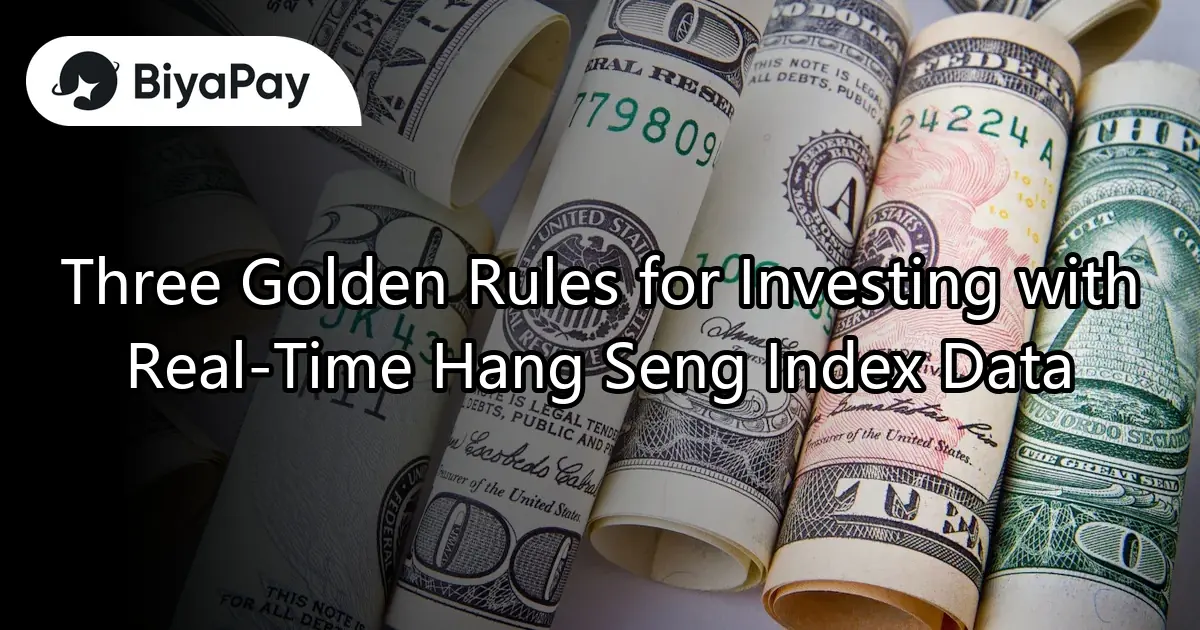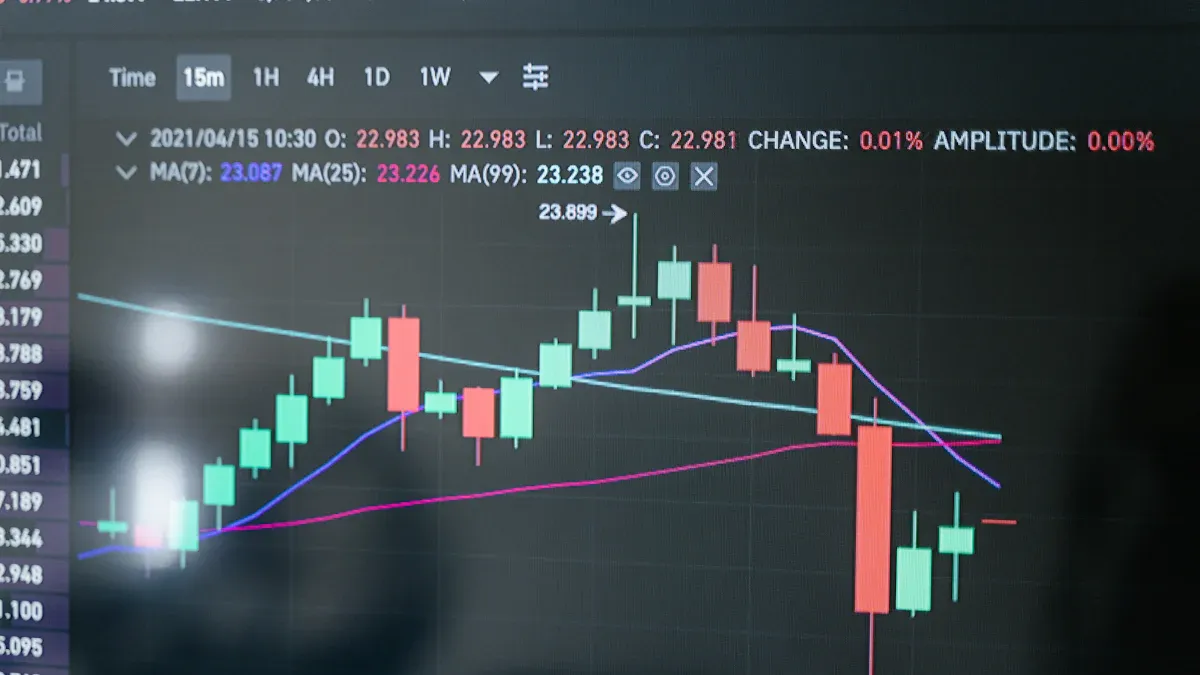- EasyCard
- Trade
- Help
- Announcement
- Academy
- SWIFT Code
- Iban Number
- Referral
- Customer Service
- Blog
- Creator
Three Golden Rules for Investing with Real-Time Hang Seng Index Data

Image Source: unsplash
When you invest, real-time Hang Seng Index data is your great assistant. You can instantly grasp market dynamics, allowing you to make decisions faster. Have you ever thought about how to use this data to improve your investment efficiency? By learning to effectively utilize real-time Hang Seng Index information, you can easily keep your finger on the market’s pulse and make wiser choices.
Are you ready to apply new methods to your daily investments? Start now!
Key Points
- Utilize real-time Hang Seng Index data and set custom alerts to instantly capture significant market changes, improving your investment response speed.
- Combine technical and fundamental analysis, using indicators like moving averages and RSI alongside market news to make more accurate entry and exit decisions.
- Develop and backtest volatility judgment strategies to reduce emotional interference, enhancing decision-making objectivity and confidence.
- Set stop-loss points and target prices, using automated order functions to control risks, avoid expanding losses, and seize profit opportunities.
- Diversify investments across different assets and regularly review your portfolio to reduce single-asset risk and enhance long-term return stability.
Real-Time Hang Seng Index Monitoring

Image Source: pexels
Data Alert Settings
Do you want to instantly track real-time changes in the Hang Seng Index? Many investment platforms and mobile apps now support custom alert functions. You can set automatic notifications based on your investment goals when the index rises or falls to a specific level. For example, when the Hang Seng Index breaks through 20,000 points in real-time, the system will send an instant push notification, ensuring you don’t miss any critical moments.
Tip: You can set multiple alerts simultaneously, such as high and low points, unusual trading volume, or changes in specific constituent stocks, to monitor market dynamics more comprehensively.
Choosing the right investment tools is also important. You can select ETFs, futures, or CFDs based on your risk tolerance and goals. ETFs are suitable for those looking to diversify risk, while futures and CFDs are ideal for those pursuing short-term volatility. Regardless of your choice, real-time Hang Seng Index data can help you react instantly.
Volatility Timing Judgment
You need to learn how to use real-time Hang Seng Index volatility to judge entry or exit timing. Many professional investors refer to metrics like price-to-earnings ratios, constituent stock composition, and market cycles, which are important reference indicators. You can create your own watchlist and regularly review these data.
Volatility timing strategies are not based on gut feelings. Professional investors use historical data for backtesting to verify strategy effectiveness. Here’s a common process:
- Backtest the strategy with historical data to see if it was effective in the past.
- Conduct in-sample and out-of-sample tests to ensure the strategy is stable across different periods.
- Simulate real-world scenarios with paper trading to check strategy feasibility.
- After deploying real capital, continuously monitor strategy performance.
- Evaluate performance using metrics like Sharpe ratio and maximum drawdown.
- Keep the strategy logic clear to avoid over-optimization.
Quantitative trading strategies, through extensive historical data backtesting, can reduce emotional interference and enhance decision-making objectivity. By effectively using real-time Hang Seng Index data with these methods, you can seize market opportunities with greater confidence.
Technical Analysis Application

Image Source: pexels
Technical Indicators
Do you want to enhance your ability to analyze the Hang Seng Index? Technical analysis tools can help you achieve this. The most common ones include moving averages, RSI (Relative Strength Index), candlestick charts, and trading volume. Moving averages help you identify the overall trend of the Hang Seng Index. RSI is used to determine if the market is overheated or oversold. Candlestick charts allow you to see price fluctuations at a glance, while trading volume reflects market participation.
You can start like this:
- Add moving averages and RSI indicators to your investment platform.
- Observe the real-time trends and trading volume of the Hang Seng Index daily.
- When RSI exceeds 70, the market may be overheated; when below 30, it may be oversold.
- Use candlestick charts to identify optimal entry or exit points.
Tip: You can use a table to record daily real-time Hang Seng Index data for easier comparison and analysis.
Real-Time Hang Seng Index Integration
Relying solely on technical indicators is not enough. You need to learn to combine technical analysis with fundamental analysis. Fundamental analysis includes company financial reports, market news, and economic data. When you notice significant real-time fluctuations in the Hang Seng Index, don’t just look at charts; also pay attention to news and constituent stock changes.
For example, if the Hang Seng Index suddenly drops in real-time, you can first use technical indicators to determine if it’s oversold, then check for major news or policy changes. This allows you to make more comprehensive judgments and reduce erroneous decisions.
Remember, technical analysis shows you the data, while fundamental analysis helps you understand the reasons. Combining both makes your investment decisions more accurate.
Risk Management Strategies
Stop-Loss and Target Price
What’s your biggest fear when investing in the Hang Seng Index? Many fear expanding losses. You can use stop-loss points and target prices to set boundaries for yourself. For example, if you buy a Hang Seng Index ETF at an entry price of 20,000 points, you can set a stop-loss at 19,500 points. If the Hang Seng Index falls below this level in real-time, you automatically sell to minimize losses. Target prices are equally important; for instance, if you expect the index to rise to 21,000 points, you can take profits to avoid missing the best opportunity due to greed.
You can use the automated order function on investment platforms to preset stop-loss and target prices. This way, even if you’re not at your computer, orders can be executed automatically based on market changes. Remember to periodically review and adjust these settings based on real-time Hang Seng Index volatility to keep your strategy flexible.
Diversified Investment
You must never put all your funds in one basket. Diversified investment involves allocating funds to different assets, such as stocks, bonds, and real estate funds. This way, even if one asset underperforms, others can help mitigate the risk. According to a 1991 study in the Financial Analysts Journal, diversified investment impacts over 90% of a portfolio’s long-term returns. Data shows that a single high-yield bond asset has an average annual return of 7.1%, but a multi-asset portfolio can achieve 8.7% under the same risk level. This proves that diversification not only reduces single-asset risk but also has the potential to enhance overall returns.
You should regularly review your investment portfolio, especially if you’re a long-term investor. Monitor the performance of Hang Seng Index constituent stocks and select stable, high-quality companies to keep your portfolio healthy. Remember, diversification and periodic reviews are the keys to long-term success.
After mastering these three golden rules, you’ll invest with more confidence. Numerous studies prove that consistently applying these methods leads to better long-term performance:
- From 1920 to 2020, U.S. stock market data shows that continuous buying outperforms waiting for market lows.
- Global stock markets in 39 developed countries have risen over the long term, with a loss probability of only about 12% over a 30-year investment period.
- SPIVA analysis found that 75% of active funds underperform the market within five years, making index-based investing more advantageous.
You can incorporate these rules into your daily investment process to improve decision-making efficiency. Remember, continuous learning and practice are essential for steady progress in the market. If you have insights or questions, feel free to leave a comment below and share your experiences with others!
FAQ
Where can I find free real-time Hang Seng Index data?
You can access real-time Hang Seng Index data on several major Hong Kong financial websites or mobile apps, such as Yahoo Finance, Investing.com, and apps from major Hong Kong banks, all offering free real-time information.
Is there a minimum investment amount for Hang Seng Index ETFs?
Most Hong Kong brokers have a minimum entry fee of approximately USD 100, though the actual amount may vary with exchange rates. You should check the latest requirements on your broker’s platform.
Can I use both technical and fundamental analysis simultaneously?
Of course, you can. You can use technical indicators to identify entry points and fundamental analysis to assess company quality. Combining both makes your decisions more comprehensive.
How do I set a reasonable stop-loss point?
You can set stop-loss points based on your risk tolerance. A common recommendation is to limit losses to no more than 5% of your capital per trade. You can use the automated order function on investment platforms.
Does diversified investment always reduce risk?
Diversified investment can help spread single-asset risk, but during market crashes, all assets may decline. You should regularly review your portfolio to stay flexible.
In 2025, the Hang Seng Index’s volatility demands smart use of real-time data and risk management strategies like stop-loss and diversification. BiyaPay simplifies fund management, enabling investments in Hang Seng Index-related ETFs and other assets without extra overseas accounts—start now at BiyaPay! With transfer fees as low as 0.5% and coverage across 190+ countries, it supports global investing.
Real-time exchange rate queries track global currency dynamics, complemented by economic calendar monitoring of market news and data. Its 5.48% annualized yield wealth product offers flexible withdrawals for liquidity. Regulated internationally, it ensures secure trading. Visit BiyaPay today to build a robust investment portfolio!
*This article is provided for general information purposes and does not constitute legal, tax or other professional advice from BiyaPay or its subsidiaries and its affiliates, and it is not intended as a substitute for obtaining advice from a financial advisor or any other professional.
We make no representations, warranties or warranties, express or implied, as to the accuracy, completeness or timeliness of the contents of this publication.




Contact Us
Company and Team
BiyaPay Products
Customer Services
is a broker-dealer registered with the U.S. Securities and Exchange Commission (SEC) (No.: 802-127417), member of the Financial Industry Regulatory Authority (FINRA) (CRD: 325027), member of the Securities Investor Protection Corporation (SIPC), and regulated by FINRA and SEC.
registered with the US Financial Crimes Enforcement Network (FinCEN), as a Money Services Business (MSB), registration number: 31000218637349, and regulated by FinCEN.
registered as Financial Service Provider (FSP number: FSP1007221) in New Zealand, and is a member of the Financial Dispute Resolution Scheme, a New Zealand independent dispute resolution service provider.



















